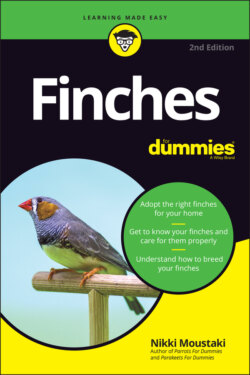Читать книгу Finches For Dummies - Nikki Moustaki - Страница 15
Anatomy of a Finch
ОглавлениеKnowing the parts of your finch is a good idea so that you can describe a problem to an avian veterinarian or an online finch group if you have to do so. Knowing the different parts of your finches is also a good idea if you’re going to breed or show your birds. This way you can speak like an expert with other hobbyists. Here are the parts of your finch you’ll want to be familiar with (see Figure 1-2 for an illustration).
Crown: The crown is simply the top of the head. It’s an important word to know in finch-speak because many finches are identified by the color of the crown.
Nares: The nares (nostrils) are at the top of the beak and may not be visible because they’re often covered by fine feathers.
Beak: The upper and lower mandibles make up the finch’s beak. In the case of a finch, it’s short, wide, and rather triangular in shape. This is for crushing the tiny hard seeds that make up most of your finch’s diet. The beak is made from the same tough material that makes your fingernails.
Ear and ear coverts: Your finch has tiny flat holes for ears, and they’re covered by coverts, or tiny flaps of skin bearing feathers, which protect them from the wind when flying. This is why your finch’s ears are difficult to see.
Eyes: The finch’s eyes are on either side of its head so that it can see a wider area than you can see with your forward-facing eyes. A finch needs a wider range of vision because it’s a prey animal and needs to be on the alert for predators. Finches, like many birds, have a third eyelid called a nictitating membrane, a thin semitransparent lid that washes the eye like a squeegee and closes for protection.
Throat: The throat is just beneath the beak and extends to the breast. Many finch species are identified partially by the color of the plumage at the throat.
Nape: The nape is the back of the neck.
Shoulder: The shoulder is at the top of the wing, nearest the finch’s back.
Breast: The breast is just below the throat.
Foot: Everything that most people think of as a bird’s leg is actually a bird’s foot. That’s why the “knee” appears to bend the wrong way — what you may be thinking of as the bird’s knee is actually the heel. As for toes, finches have three front toes and one toe that grips to the rear.
Vent: The vent is where your finch eliminates waste (and also lays eggs if it is a hen). In a human, this would be a combined anus and urethra. Birds do not urinate.
Primary feathers: Finches have ten long primary wing feathers that aid in flight.
Secondary feathers: The secondary feathers on the wing occur after the primary feathers; they’re smaller and closer to the body than the primaries are.
Rump: The rump is beneath the primary flight feathers on the finch’s lower back.
Mantle: The mantle is the bird’s back.
Crop: The crop is a sac-like organ that’s kind of like a “first stomach.” It’s where the food goes immediately after being swallowed and is located at the breast. You can see the crop very well in baby birds.
Gizzard: The gizzard is like a “second stomach” that grinds food to digest it.
Syrinx: The syrinx is equivalent to vocal chords in humans. It allows finches to sing when air is pushed through it.
FIGURE 1-2: The anatomy of a finch.
